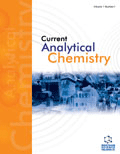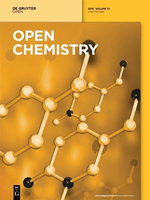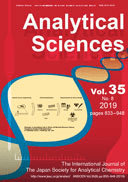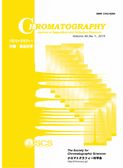
Current Analytical Chemistry
Scope & Guideline
Bridging research and application in analytical chemistry.
Introduction
Aims and Scopes
- Environmental Analysis:
The journal publishes research on analytical techniques for environmental monitoring, including the detection and quantification of pollutants, heavy metals, and emerging contaminants in water, soil, and air. - Biomedical Applications:
A significant focus is on the development and validation of analytical methods for pharmaceuticals, biomarkers, and drug delivery systems, particularly in the context of improving healthcare outcomes. - Nanotechnology in Analysis:
Current Analytical Chemistry frequently features studies on nanomaterials and their applications in sensing, drug delivery, and environmental remediation, highlighting the innovative use of nanotechnology in analytical chemistry. - Method Development and Validation:
The journal emphasizes the importance of developing robust, reproducible analytical methods, including chromatographic, spectroscopic, and electrochemical techniques, with a focus on their validation for various applications. - Computational and Chemometric Approaches:
Research that employs computational methods and chemometrics to enhance analytical techniques, data interpretation, and method optimization is a recurring theme, showcasing the integration of computational chemistry with analytical practices.
Trending and Emerging
- Machine Learning and Data Analysis:
The integration of machine learning and artificial intelligence in data analysis and method development is rapidly gaining traction, with researchers exploring how these technologies can enhance analytical processes and improve accuracy. - Green Chemistry and Sustainable Practices:
There is a growing emphasis on sustainable analytical practices, including green chemistry approaches for method development and the use of eco-friendly materials in analytical processes. - Advanced Nanomaterials for Sensing:
Research focused on the development and application of advanced nanomaterials for sensing, including biosensors and environmental sensors, is trending, highlighting the innovative use of nanotechnology in analytical applications. - Interdisciplinary Approaches:
Current Analytical Chemistry is increasingly featuring interdisciplinary research that combines analytical chemistry with biology, materials science, and environmental science, reflecting a holistic approach to solving complex analytical challenges. - Emerging Contaminants and Environmental Monitoring:
There is a notable increase in research addressing emerging contaminants in environmental samples, driven by heightened awareness of their impact on health and ecosystems, leading to innovative detection and remediation strategies.
Declining or Waning
- Traditional Chromatographic Methods:
There has been a noticeable decline in publications focusing exclusively on traditional chromatographic techniques, as researchers increasingly explore more advanced methods and technologies that offer greater efficiency and sensitivity. - Basic Qualitative Analysis:
Research centered on fundamental qualitative analysis without the integration of advanced techniques or modern instrumentation appears to be waning, as the field moves towards more quantitative, high-throughput methods. - Single-Use or Low-Throughput Methods:
The trend towards sustainability and efficiency has led to a decline in interest in single-use or low-throughput analytical methods, with more researchers favoring methods that can handle larger sample sizes and provide quicker results. - Non-Nanotechnology Based Sensors:
As the field of analytical chemistry increasingly embraces nanotechnology, traditional sensor designs that do not incorporate nanomaterials are being published less frequently, reflecting a shift in research focus. - Conventional Spectroscopic Techniques:
The exploration of conventional spectroscopic techniques is decreasing as newer, more sophisticated techniques gain prominence, particularly those that integrate computational analysis for enhanced data interpretation.
Similar Journals

CHINESE JOURNAL OF ANALYTICAL CHEMISTRY
Advancing Analytical Excellence in ChemistryCHINESE JOURNAL OF ANALYTICAL CHEMISTRY, published by SCIENCE PRESS in China, stands as a prominent platform in the field of analytical chemistry since its inception in 1989. With its ISSN 0253-3820 and E-ISSN 1872-2040, the journal maintains a vital role in disseminating empirical research and innovative methodologies, contributing to the advancement of analytical techniques and their applications. The 2023 Scopus ranking positions the journal in the third quartile (Q3) within its category, reflecting a respectable standing among its peers. Researchers, professionals, and students alike engage with a broad range of topics, from instrumental analysis to environmental monitoring, each aiming to foster further scientific inquiry. Although it does not currently offer Open Access, the journal's rich repository of knowledge continues to be an essential resource for those in the analytical chemistry community, with an enduring commitment to scientific excellence and collaboration.

JOURNAL OF ANALYTICAL CHEMISTRY
Catalyzing Progress in Analytical ChemistryJOURNAL OF ANALYTICAL CHEMISTRY, published by PLEIADES PUBLISHING INC, stands as a pivotal resource in the field of analytical chemistry, offering an innovative platform for researchers, professionals, and students to advance their knowledge and contribute to the discourse within the discipline. With an ISSN of 1061-9348 and an E-ISSN of 1608-3199, this journal features a focused exploration of analytical methodologies, instrumentation developments, and applications across various domains, contributing to practical and theoretical advancements in the field. Currently ranked in the Q3 category in Analytical Chemistry with a Scopus rank of #111 out of 156, it provides critical insights and innovation strategies for professionals aiming to enhance their analytical capabilities. Access to the journal is through standard subscription models, and it covers an extensive range of topics pertinent to the discipline from 1996 to 2024. Engage with the JOURNAL OF ANALYTICAL CHEMISTRY to be part of a vibrant research community dedicated to push the boundaries of analytical practices.

Separation Science Plus
Pioneering the future of analytical chemistry.Separation Science Plus is an emerging academic journal dedicated to advancing the field of analytical chemistry and separation science. Published by WILEY-VCH Verlag GmbH, this journal provides a platform for researchers to disseminate high-quality studies and reviews that address innovative techniques and breakthroughs in separation methodologies. With its ISSN 2573-1815, the journal has made significant inroads since its inception in 2018, encompassing a convergence period until 2024. Despite currently holding a Q3 ranking in Analytical Chemistry and a Q4 ranking in Filtration and Separation, its dedication to publishing impactful research makes it a vital resource for professionals and students alike. The journal operates under the robust scholarly reputation of WILEY, which is known for its commitment to excellence in scientific communication. Researchers interested in the latest advancements in separation techniques will find Separation Science Plus an essential read, fostering the exchange of knowledge and facilitating greater understanding within this specialized field.

ACTA CHROMATOGRAPHICA
Fostering Collaboration in the World of ChromatographyACTA CHROMATOGRAPHICA is a distinguished academic journal dedicated to the field of chromatography and its applications, published by AKADEMIAI KIADO ZRT. With a history spanning from 1996 to 2024, this journal serves as a vital platform for the dissemination of innovative research and advancements within the field, contributing significantly to the body of knowledge in the domain of general chemistry. Operating out of Budapest, Hungary, ACTA CHROMATOGRAPHICA holds a Q3 ranking in the chemistry category as of 2023, reflecting its impact and relevance among its peers, achieving a Scopus ranking of 180 out of 408 in the General Chemistry category, placing it in the 56th percentile. While not currently Open Access, the journal offers robust subscription options for readers and institutions seeking to stay informed on the latest developments in chromatography. FACTA CHROMATOGRAPHICA aims to foster communication, collaboration, and discovery, making it an essential resource for researchers, professionals, and students seeking to enhance their expertise in this evolving field.

International Journal of Analytical Chemistry
Transforming Ideas into Innovations in Analytical ScienceInternational Journal of Analytical Chemistry, published by HINDAWI LTD, is a leading open access platform that has been advancing the field of analytical chemistry since its inception in 2009. With an ISSN of 1687-8760 and an E-ISSN of 1687-8779, this journal is headquartered in Egypt and serves a global audience, publishing high-quality research and reviews that explore innovative methodologies, techniques, and applications in analytical chemistry. Ranked in the Q3 quartile, the journal holds a notable position within its category, specifically at #90 out of 156 in the Scopus ranks for Analytical Chemistry, showcasing its impact within the scientific community. Researchers, professionals, and students can access a wealth of knowledge freely, as the journal promotes open access to facilitate the dissemination of critical research innovations. By bridging the gap between theoretical advancements and practical applications, the International Journal of Analytical Chemistry continues to play a pivotal role in shaping the future of analytical practices.

Open Chemistry
Bridging Gaps in Chemical Sciences with Open AccessOpen Chemistry, published by DE GRUYTER POLAND SP Z O O, is a distinguished peer-reviewed journal that has been serving the global chemistry community since its inception. With an ISSN of 2391-5420 and an E-ISSN also of 2391-5420, this open-access journal has been accessible to researchers and practitioners alike since 2015, ensuring a wide dissemination of high-quality research findings. Located in Germany, specifically at BOGUMILA ZUGA 32A STR, 01-811 WARSAW, MAZOVIA, POLAND, Open Chemistry aims to publish innovative research across various chemical disciplines, with special attention to miscellaneous chemistry and materials chemistry. It is currently ranked in the Q3 category for both fields as of 2023, reflecting its solid standing within the academic community, with specific ranks of 187/408 in General Chemistry and 153/317 in Materials Chemistry, corresponding to respective percentiles of 54 and 51. Open Chemistry not only enhances the accessibility of cutting-edge research but also serves as a vital resource for students, professionals, and scholars seeking to advance their knowledge in the rapidly evolving landscape of chemical sciences.

ANALYTICAL SCIENCES
Connecting Scholars, Inspiring InnovationsANALYTICAL SCIENCES, published by SPRINGERNATURE, is a prestigious journal established in 1985 dedicated to advancing the field of analytical chemistry. With an ISSN of 0910-6340 and an E-ISSN of 1348-2246, this journal plays a critical role in disseminating high-quality research and innovative methodologies. Operating from Switzerland, it aims to provide a platform for scholars, researchers, and professionals to explore significant developments and applications in analytical techniques. Although classified in the third quartile (Q3) of analytical chemistry, which places it in a competitive framework (Rank #96/156, 38th Percentile in Scopus), its impact on the discipline is noteworthy. While it is not currently an open-access journal, the resources within are invaluable for those seeking to stay at the forefront of research and practice in analytical sciences, making it an essential read for anyone involved in this dynamic field. The journal continues to converge critical insights from 1985 to 2024, fostering a community dedicated to innovation and excellence in analytical chemistry.

Chromatography
Transforming sample analysis with cutting-edge chromatographic research.Chromatography is an esteemed journal published by the SOC CHROMATOGRAPHIC SCIENCES, dedicated to advancing the field of chromatographic techniques and their applications across various disciplines, including analytical chemistry, biochemistry, and environmental science. By facilitating the exchange of high-quality research, Chromatography plays a pivotal role in enhancing methodologies and technologies that drive innovation in sample analysis. While the journal is not currently open access, it maintains a rigorous peer-review process, ensuring the publication of valuable and impactful studies. Researchers, professionals, and students alike can benefit from its comprehensive coverage of chromatography-related advancements, making it a vital resource for anyone engaged in this dynamic area of study.

Brazilian Journal of Analytical Chemistry
Empowering Researchers Through Open Access KnowledgeBrazilian Journal of Analytical Chemistry, published by VISAO FOKKA COMMUNICATION AGENCY, serves as a vital platform for those engaged in the field of analytical chemistry, especially within the Latin American context. With an ISSN of 2179-3425 and an E-ISSN of 2179-3433, this journal aims to promote high-quality research and advancements in analytical methodologies, instrumentation, and applications spanning from 2010 to the present. Although it currently holds a Q4 rank in Analytical Chemistry by Scopus and is placed at the 24th percentile, its commitment to open access publishing provides invaluable opportunities for widespread dissemination of knowledge, catering to researchers, professionals, and students alike. The journal's editorial board comprises emerging and established experts aiming to bridge gaps in analytical chemistry research, particularly in a Brazilian and broader South American context. Situated in São Paulo, Brazil, the journal's role in fostering innovation and collaboration in analytical techniques makes it an essential resource for the academic community.

Talanta Open
Innovating Insights in Chemical AnalysisTalanta Open (ISSN: 2666-8319) is a prominent open-access journal published by Elsevier, dedicated to advancing the field of Analytical Chemistry. Established in 2020, the journal aims to foster innovative research and facilitate knowledge sharing in the analysis of chemical substances and their interactions. With an impressive Q2 ranking in the Analytical Chemistry category and a commendable Scopus ranking of #57/156, Talanta Open has quickly established itself as a vital resource for researchers, professionals, and students alike. The journal is known for its rigorous peer-review process and commitment to quality, ensuring that published content significantly contributes to the scientific community. By providing unrestricted access to high-quality research, Talanta Open underscores the importance of collaboration and accessibility in the ever-evolving landscape of analytical science.